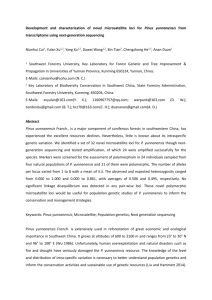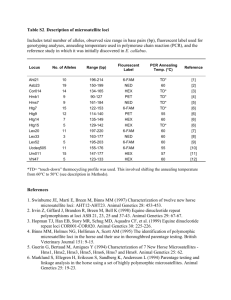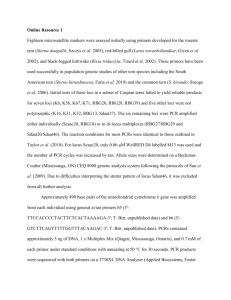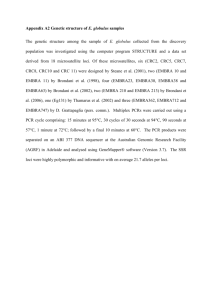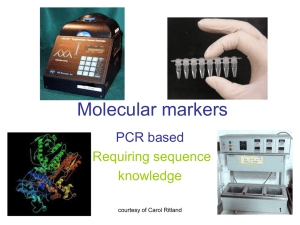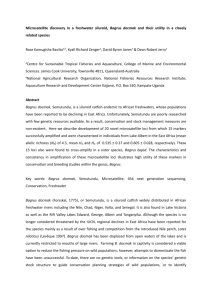Microsatellite markers in avocado Persea americana of dinucleotide and trinucleotide markers V.E.T.M. Ashworth
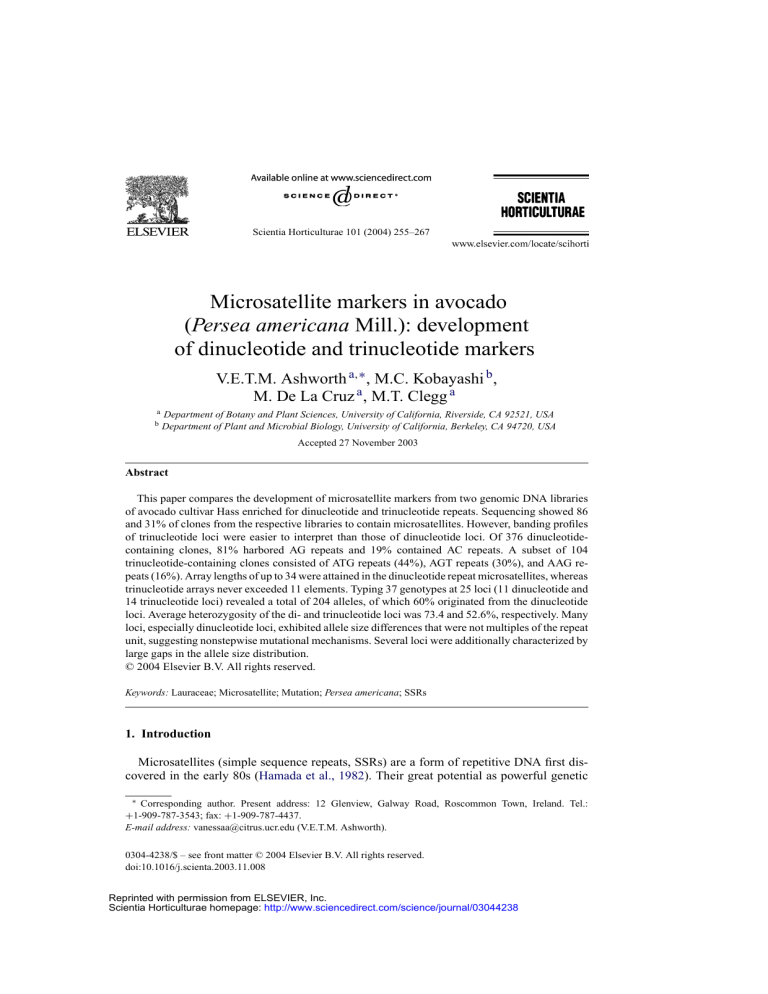
Scientia Horticulturae 101 (2004) 255–267
Microsatellite markers in avocado
(Persea americana Mill.): development of dinucleotide and trinucleotide markers
V.E.T.M. Ashworth a
, ∗
, M.C. Kobayashi
M. De La Cruz a
, M.T. Clegg a b , b a
Department of Botany and Plant Sciences, University of California, Riverside, CA 92521, USA
Department of Plant and Microbial Biology, University of California, Berkeley, CA 94720, USA
Accepted 27 November 2003
Abstract
This paper compares the development of microsatellite markers from two genomic DNA libraries of avocado cultivar Hass enriched for dinucleotide and trinucleotide repeats. Sequencing showed 86 and 31% of clones from the respective libraries to contain microsatellites. However, banding profiles of trinucleotide loci were easier to interpret than those of dinucleotide loci. Of 376 dinucleotidecontaining clones, 81% harbored AG repeats and 19% contained AC repeats. A subset of 104 trinucleotide-containing clones consisted of ATG repeats (44%), AGT repeats (30%), and AAG repeats (16%). Array lengths of up to 34 were attained in the dinucleotide repeat microsatellites, whereas trinucleotide arrays never exceeded 11 elements. Typing 37 genotypes at 25 loci (11 dinucleotide and
14 trinucleotide loci) revealed a total of 204 alleles, of which 60% originated from the dinucleotide loci. Average heterozygosity of the di- and trinucleotide loci was 73.4 and 52.6%, respectively. Many loci, especially dinucleotide loci, exhibited allele size differences that were not multiples of the repeat unit, suggesting nonstepwise mutational mechanisms. Several loci were additionally characterized by large gaps in the allele size distribution.
© 2004 Elsevier B.V. All rights reserved.
Keywords: Lauraceae; Microsatellite; Mutation; Persea americana; SSRs
1. Introduction
Microsatellites (simple sequence repeats, SSRs) are a form of repetitive DNA first discovered in the early 80s ( Hamada et al., 1982 ). Their great potential as powerful genetic
∗
Corresponding author. Present address: 12 Glenview, Galway Road, Roscommon Town, Ireland. Tel.:
+
1-909-787-3543; fax:
+
1-909-787-4437.
E-mail address: vanessaa@citrus.ucr.edu (V.E.T.M. Ashworth).
0304-4238/$ – see front matter © 2004 Elsevier B.V. All rights reserved.
doi:10.1016/j.scienta.2003.11.008
Reprinted with permission from ELSEVIER, Inc.
Scientia Horticulturae homepage: http://www.sciencedirect.com/science/journal/03044238
256 V.E.T.M. Ashworth et al. / Scientia Horticulturae 101 (2004) 255–267 markers, combining the useful properties of high variability, co-dominant inheritance, and
). Over the past decade microsatellites have assumed a central role in population-level studies as well as in breeding applications because their co-dominance makes them suitable for tracing paternity and tracking pollen movement (see for reviews
Queller et al., 1993; Jarne and Lagoda, 1996;
Goldstein and Pollock, 1997; Goldstein and Schlötterer, 1999; Sunnucks, 2000 ). Addition-
ally, they are abundant and evenly distributed across the genome (
Stallings et al., 1991; Weissenbach et al., 1992
), making them amenable to the study of genealogical relationships (
The repetitive unit of microsatellites is generally defined as being one to five bases long.
Dinucleotide repeats are the most common category of repeat in a majority of organisms
( Jurka and Pethiyagoda, 1995; Tóth et al., 2000; Katti et al., 2001
) and are usually asso-
ciated with non-coding regions of the genome ( Young et al., 2000; Temnych et al., 2001 ).
Trinucleotide repeats are often found within ORFs (
Young et al., 2000 ) due to their triplet
structure. Although they do not interfere with the reading frame they are nonetheless responsible for several human diseases, once repeated arrays exceed a threshold limit. In plants, trinucleotide microsatellites are relatively infrequent (
Lagercrantz et al., 1993; Ma et al., 1996 ), compared with vertebrates and some other organisms.
Our goal is to develop microsatellite markers in order to expedite avocado breeding and selection that is currently hampered by a long generation time and the inability to perform controlled pollinations. A (diploid) member of the family Lauraceae, avocado belongs to one of the earliest lineages in the angiosperm phylogeny that predates the origin of the
Eudicots (
Zanis et al., 2002 ; http://www.mobot.org/MOBOT/Research/Apweb/html
). Few
DNA sequences of Lauraceae are deposited in the public sequence databases, precluding their use in the development of microsatellite loci. In this paper we compare the efficiency of marker development from a dinucleotide- and trinucleotide-enriched library. Respective marker types serve different—albeit overlapping—functions, viz. mapping using segregating progeny versus diversity studies over a range of germplasms. Allelic diversity at 25 marker loci is compared for a panel of 37 avocado genotypes, including 35 cultivars and two wild relatives (P. schiedeana and P. steyermarkii). Data on genealogical relationships are presented elsewhere (
2. Materials and methods
2.1. Library construction
Due to the paucity of avocado DNA sequences in the DNA sequence databases we commissioned two microsatellite-enriched libraries from GIS (Genetic Identification Services
Inc., Chatsworth, CA). The libraries were generated from total genomic DNA of avocado cultivar Hass digested with restriction enzymes HaeIII, PvuII, ScaI, StuI, BsrbI, RsaI and
EcoRV. A preliminary screen (data not shown) of the genomic DNA using probes to three dinucleotide and three trinucleotide repeat motifs showed GA, AAG and ATG to be the most abundant. The dinucleotide-enriched library was prepared against the motif GA. The
V.E.T.M. Ashworth et al. / Scientia Horticulturae 101 (2004) 255–267 257 trinucleotide-enriched library was prepared against the motif ATG. Genomic fragments enriched for microsatellites were cloned into the HindIII cut site of plasmid pUC19 that was incorporated into Escherichia coli strain DH5
␣ by electroporation.
2.2. Colony screening
Cells were spread on agar plates containing 100
l of 2% BluoGal or X-Gal, 10
l of
100 mM IPTG, and ampicillin (50 mg/ml) to eliminate vectors lacking an insert (blue).
Additionally, inserts were screened for the correct size (ca. 350–1000 bp) by PCR using the M13 universal primers located in the plasmid flanks. Cells from each positive (white) colony were transferred to 0.2 ml microfuge tubes containing 10
l aliquots of 1
l 10
× buffer (Qiagen, Valencia, CA), 3 mM dNTPs, 0.15
M forward and reverse primer, and
0.05 units Taq DNA polymerase. PCR settings were 1 min at 94
94
◦
C, 1 min at 57
◦
C, 1 min at 72
◦
◦
C, 35 cycles of 1 min at
C, and a final extension of 2 min at 72
◦
C. PCR products were run out on a 2% agarose gel with a 100 bp DNA ladder (Promega, Madison, WI) as the size standard. Clones devoid of an insert, clones containing inserts that were too small or too long, or clones that harbored two or more inserts were excluded from further analysis.
2.3. Sequencing of inserts
For sequencing, suitable clones were cultured overnight in LB medium
+ amp and purified
(Qiagen Spin Miniprep Kit; Qiagen, Valencia, CA). The sequencing reaction consisted of
1
l fluorescently labeled IRDye primer (1
M; LI-COR, Lincoln, NE), 7.2
l 3.5
×
DNA sequencing buffer, 2
l of each dNTP mix (G mix: 0.03 mM ddGTP, 135
M each of dATP, dCTP, dTTP, and 7-deaza-dGTP; A mix: 0.2625 mM ddATP, 67.5
M each of dATP, dCTP, dTTP, and 7-deaza-dGTP; T mix: 0.45 mM ddTTP, 67.5
M each of dATP, dCTP, dTTP, and 7-deaza-dGTP; C mix: 0.15 mM ddCTP, 67.5
M each of dATP, dCTP, dTTP, and 7-deaza-dGTP), and 1
l (5 units/
l) Taq DNA Polymerase (buffer, dNTP mix and
Polymerase supplied in the SequiTherm Excel
TM
II DNA Sequencing Kit-LC for 66 cm gels, Epicenter Technologies, Madison, WI), and 5–7
l of purified DNA. Thermocycler conditions consisted of 5 min at 95
1 min at 70
◦
◦
C, and 30 cycles of 1 min at 95
◦
C, 1 min at 55
◦
C, and
C. All sequences were generated on a LI-COR DNA 4200 Long Read Sequencer
(66 cm plates) on 6% acrylamide gel (Long Ranger, FMC Bioproducts, Rockland, MN;
1% ammonium persulfate, TEMED). In order to maximize efficiency, 12 reactions were generated using only the forward primer (labeled with IRD 800) and 12 using only the reverse primer (labeled with IRD 700), subjected to PCR and then pooled prior to denaturing with formamide
+
Basic Fuchsin. This allowed 24 distinct cloned fragments to be sequenced in each sequencing run.
2.4. Primer design
Sequences were edited in Sequencher version 3.1 (Gene Codes Inc., Ann Arbor, MI) and stored in a sequence library in BBEdit Lite 4.6 (Bare Bones Software Inc., Bedford, MA).
Sequences were screened for multiple representation using FASTA version 3.2t06 (
Pearson and Lipman, 1988 ). Primers were designed to unique sequences having sufficiently long
258 V.E.T.M. Ashworth et al. / Scientia Horticulturae 101 (2004) 255–267 flanks either side of the microsatellite locus and at least four perfect trinucleotide repeats or at least seven perfect dinucleotide repeats. All primer pairs were selected using Oligo
Primer Analysis Software version 4.01 (National Biosciences Inc., Plymouth, MN). Base composition, annealing temperature, and product size for the 25 microsatellite loci used in this study are presented in
2.5. Fragment amplification
PCR reactions were visualized by either radioactivity or fluorescence. In the radioactive method reaction mixtures (10
l total volume) contained 1
l 10
× buffer (containing 15 mM
MgCl
2
; Qiagen Taq DNA Polymerase kit, Valencia, CA), 0.19
M dATP, dGTP and dTTP,
0.067
M dCTP, and 0.017
M
␣
-
32
P-dCTP (NEN EasyTides, Perkin Elmer Life Sciences),
0.8
l MgCl
2
(25 mM), 1
l each primer (1.5 pmol/
l), 0.5
l Taq polymerase (5 units/
l), and 1–2
l DNA (10–20 ng/
l). In the fluorescent method 10
l reactions consisted of
1
l 10
× buffer (containing 15 mM MgCl
2
; Qiagen Taq DNA Polymerase kit, Valencia,
CA), 1.15
l dNTPs (1.25 mM), 0.5
l MgCl
2
(25 mM), 1.15
l labeled fluorescent forward primer (1.5 pmol/
l; ABI fluorescent dyes 6-FAM, VIC, NED), 1.15
l unlabelled reverse primer (1.5 pmol/
l), 0.08
l Taq Polymerase (5 units/
l), and 1–2
l DNA (10–20 ng/
l).
All reactions were performed on a Stratagene Robocycler (Stratagene Inc., La Jolla, CA).
The following settings were used: 2 min at 95
(depending on the primer) for 1 min, and 72 at 72
◦
C.
◦
◦
C, 30 cycles of 95
◦
C for 1 min, 50–68
◦
C
C for 1 min, with a final extension of 45 min
2.6. Fragment visualization
Radioactively labeled reaction products were denatured with 3
l of a solution containing
0.03% Bromophenol Blue and 20 mM EDTA in formamide, and run out on an acrylamide gel for 1.5–2.5 h. After electrophoresis, the gel plates were separated and the gel allowed to dry.
Bands were visualized by exposure of X-Omat AR film (Eastman Kodak, Rochester, NY) to the gel for 2–24 h and scored manually. Fluorescently labeled reaction products were combined with ROX 500 size standard and denatured with ABI Loading Buffer (50 mg/ml Blue
Dextran, 25 mM EDTA, and de-ionized formamide) and electrophoresed on an ABI 377
Automated DNA Sequencer (Perkin Elmer Applied Biosystems). Fragment sizes were calculated using ABI GeneScan software, and adjusted using the known product size in cultivar
Hass. Distances between called fragment sizes were compared with actual band distances appearing on the electrophoretogram, as recommended by
3. Results
3.1. Microsatellite marker yields
Table 2 contrasts marker yields from the dinucleotide- and trinucleotide-enriched DNA
libraries at successive stages of marker development. The main difference between the two marker development strategies is the number of clones containing microsatellites. We
V.E.T.M. Ashworth et al. / Scientia Horticulturae 101 (2004) 255–267 259
Table 1
Primer and PCR product specifications for 25 microsatellite loci of avocado
Primer name Base composition T m
(
◦
C) Repeat type
AVT.386F
AVT.386R
AVT.436F
AVT.436R
AVT.448F
AVT.448R
AVT.517F
AVT.517R
AVO.102F
AVO.102R
AVD.001F
AVD.001R
AVD.002F
AVD.002R
AVD.003II.F
AVD.003R
AVD.006F
AVD.006R
AVD.013F
AVD.013R
AVT.005b.F
AVT.005b.R
AVT.020GAT.F
AVT.020GAT.R
AVT.021F
AVT.021R
AVT.038F
AVT.038R
AVT.106F
AVT.106R
AVT.143F
AVT.143R
AVT.158F
AVT.158R
AVT.191F
AVT.191R
AVT.226F
AVT.226R
AVT.372F
AVT.372R
AVD.015F
AVD.015R
AVD.017F
AVD.017R
AVD.018F
AVD.018R
AVD.022F
AVD.022R
AUCR.418F
AUCR.418R
TTAGCAGCAGATAGAGGGAGAG
GGACCTGCCTTGTGGATTAG
CTACATAGATCGAAATAAGG
ATCTGGCTATGAAATGTTGG
ACTCTCGCCTCTGCGTTGAT
GACTCAACATGGTTAGAACAAGGC
GATTAAAGATGACCCTGAAG
GATTTGGCTCAAGATAGATC
CCAATCAAAAGGCAAACGAAGAAC
GCAAAGGAGGCGGTTTCGAGAT
CCCAACATCTACTTAGCGCAATAG
ATCATCATCGTCTTCACCGTCGTT
ACGAAGTTACGGGCTTATTTCACA
TTCTTCCCCTTCTCTCACATAATC
TCCACAACTTCTACAGGGTCGT
GGAAGATAACGCACCTTGAGTTC
GGCTGACTTTTATAGTCGATGT
TCCGATTGACAGTGGATTGTT
GCGAACACTACTCACATAGG
ATTTTAACTAATGGATTGGATG
ACAACCCAAACATAAATGCT
AATAGAAGTGACATCCGACC
ACTAAAATGAGGGGAGACTAG
GAGTGTAGTGAGGAGTTTGG
ACGGTGTTTGGAAGAAGATG
GCACTTCAATCAATGCTTAC
AATCCTTCCACTCAGAAACT
TACACAAACGACAAGAATGG
TTCGCCTTATCAGCGTTAG
TCTTGGAAAGCCCTACTCC
GTTTCCAAGCGACTCACGAG
GATTCCATGCTGAATTGCCG
TGCATACTCTTAGCCCCATATGT
GGATCATTGGTTTTGATAACAGG
TCCCTTCAGTCTAAGATTAGCC
GACCAACACTATTTGCCCCAC
GGGAGAGATGTATTGAGCA
ACTTGGTCGTAGATTGTAAAT
TTGCCAGTGGAACTTCAAAA
ACCCAACCAAAGATTTCAAT
GACCCCTACCCTAACTCTCA
CTTCTAAACATTCCCTACAAAG
GCTCACAAGCGAACTTTCAT
TAAATCCCCTTTCCCACCTT
TGCTGGCATAATGGCTGCTA
CAAACATCTTCAGAACCGCC
CCACTTGGATTCTTGTTGGA
ATTTGGGTTCGGCTTAGGAA
AGATGGCTTTCTCCTTCTGA
TTTGACACACAATCCAACTATG
62
54
65
56
66
66
62
68
62
58
60
56
60
59
58
66
66
63
58
63
61
64
67
65
56
CAT5
GAT9
ATC8
TCA8
TCA6
GAA8GAT6
GAT7
ATG7TGG4
TCA6.CTT4
TGA10
TGA8
ATC9
GAT8
GAT6
GA12
CT12
CT15CA13
TC19
TC9AC19
AG7.GA3.TCT4
GT26
TC18.AC8
GA20
TC13
GT12GA13
Fragment size
186
164
136
190
309
211
267
170
298
182
229
152
192
229
153
226
327
192
314
216
258
211
224
228
379
The repeat type and size of the amplification product are based on sequenced clones from a DNA library of cultivar Hass.
In column 4 (repeat type) a period between motifs denotes an interrupted microsatellite locus.
260 V.E.T.M. Ashworth et al. / Scientia Horticulturae 101 (2004) 255–267
Table 2
Comparison of microsatellite development from a dinucleotide (2n) and trinucleotide (3n) enriched DNA library of avocado
Successive stages in marker development 2n 3n
Clones sequenced
Duplicated clones
No suitable repeats present (%)
Primers designed (%)
Promising loci
233
7
14
64
20 (57% of loci screened)
493
9
69
12
26 (45% of loci screened)
Percentages for the number of clones sequenced, clones duplicated (redundant), clones lacking repeats, and clones for which primers could be designed are expressed relative to the total number of clones sequenced.
a
This comparison is inaccurate as it becomes progressively more likely for a new sequence to be identical/similar to a previous one (the dinucleotide-enriched library screened after completion of the 3n library screen).
b
Data for the two repeat categories are based on a different number of loci screened.
sequenced 493 clones from the trinucleotide-enriched library. Of these, 31% contained a trinucleotide repeat and primers could be designed to 12% (58) of the original trinucleotide clones sequenced. By contrast, 86% of the 233 clones sequenced from the dinucleotideenriched library contained repeats and primers were designed to 64% (150) of the original dinucleotide clones sequenced. Clone redundancy was noted for both enriched libraries.
Upon amplification, not all of the loci turned out to be useful (interpretable). Only 26
(45%) of the 58 amplified loci from the trinucleotide-enriched library contained highly informative bands, corresponding to a 5% yield of trinucleotide loci of 493 inserts sequenced.
Comparable figures for the dinucleotide library are preliminary. Based on a screen of 35 dinucleotide loci we found that 20 (57%) yielded informative bands. Extrapolating from this sub-sample we would expect about 133 informative loci among our 233 inserts. Overall, the dinucleotide-enriched library yielded 11 times as many informative microsatellite loci per insert sequenced than the trinucleotide-enriched library.
Although less frequent the trinucleotide repeat loci were generally easier to interpret than the dinucleotide repeat loci (
Fig. 1 ). Common problems in the interpretation of amplification
products are the appearance of excess numbers of bands, smears, and amplification failure
(null alleles).
3.2. Microsatellite motifs
Among 235 repeats (in 147 inserts) from the dinucleotide-enriched library, we found
190 AG repeats (81%), 43 AC repeats (18%), two AT repeats (1%), and GC repeats were absent. An earlier screen of the same dinucleotide-enriched library (141 repeats in 116 inserts; unpublished data) revealed similar distributions, albeit with both AT and GC repeats absent. When data from both dinucleotide screens were pooled (376 repeats), 81% of the dinucleotide clones contained AG repeats and 19% contained AC repeats, with the two AT repeats contributing 0.5%.
Fig. 2 (1) shows the frequency distribution of the two main dinucleotide motif categories.
The AG repeats were both more frequent and had longer repeat arrays compared with the AC repeats. Repeat numbers of 15 were the most common among AG arrays while 12 repeats were most common among AC arrays. The longest repeat array found was an AC repeated
V.E.T.M. Ashworth et al. / Scientia Horticulturae 101 (2004) 255–267 261
Fig. 1. Autoradiogram illustrating banding patterns of a trinucleotide (3n) microsatellite marker and a dinucleotide
(2n) microsatellite marker. The banding at the 3n locus is unambiguous, whereas that of the 2n locus was deemed uninterpretable, excluding it from use as a marker.
34 times. Interestingly, the distributions of AC repeats, but especially of AG repeats, did not describe a bell-shaped curve. Instead, frequencies of 9–10 units (AC) and 8–14 units (AG) were relatively scarce, corresponding to a dip in the curve. A single, perfect, repeat array was found in 64% of the dinucleotide loci, 15% of loci were compound (repeats of two or more different motifs arranged in tandem or within the same insert), 13% were interrupted by short regions of non-repetitive imperfections, and 8% were both compound and interrupted.
In a subset of 104 trinucleotide repeats (present at 98 distinct loci), 46 (44%) contained
ATG repeats, 32 (30%) contained AGT repeats, and 17 (16%) contained AAG repeats
(counts for each repeat motif include corresponding permutations and reverse complements thereof;
Fig. 2 (2)). Motifs based on AGG and ACC each occurred five times; AGC-
and ACG-type motifs occurred in two clones, and a single occurrence was noted for the
AAT-type motif. AAC-type and GGC-type motifs were not detected. The longest trinucleotide array contained 11 elements and the most frequently represented array length was six elements. Arrays of nine and above were rare.
3.3. Allelic composition
The repeat types of the 25 loci used to compare a panel of 37 avocado genotypes are presented in
Table 1 . In this data set, 11 of 14 trinucleotide loci contained simple repeats of no
more than 10 elements. Two loci contained compound repeats, and another locus contained
262 V.E.T.M. Ashworth et al. / Scientia Horticulturae 101 (2004) 255–267
Fig. 2. Histograms depicting the frequency of different microsatellite repeat motifs in clones sequenced from a dinucleotide-enriched library (
Fig. 2 (1)) and trinucleotide-enriched library ( Fig. 2 (2)) of avocado. (1) Frequency
of AG and AC dinucleotide repeats as a function of array length; (2) frequency of various trinucleotide repeat motifs as a function of array length.
two interrupted repeats. Among the 11 dinucleotide loci, six loci contained simple repeats, the longest consisting of 26 repeat elements. Two loci had compound repeats and two contained interrupted repeats (one included a short trinucleotide repeat). Average repeat lengths for the trinucleotide and dinucleotide categories are 8.5 and 19.4 repeat elements, respectively.
Consistent with their greater repeat lengths, dinucleotide loci were more variable than trinucleotide loci, with allele numbers of 12–21 and 3–10 per locus, respectively. The total number of alleles was 204, of which the 11 dinucleotide loci contributed 124 (60%). Many loci, especially dinucleotide loci, exhibited allele size differences that were not multiples of the repeat unit (e.g., a 1-base difference or
≥
3 bases between consecutive dinucleotide alleles;
Table 3 ). Several loci were additionally characterized by large gaps between successive
alleles (e.g., AVT143, AVO102, AVD002, AVD013, and AVD015).
V.E.T.M. Ashworth et al. / Scientia Horticulturae 101 (2004) 255–267 263
Table 3
Allele sizes and size intervals at 25 microsatellite loci for 37 avocado genotypes
Sequential allele size intervals (nucleotides) Locus Allele size range
AVT005b 186–201
AVT020gat 152–179
AVT021
AVT038
AVT106
AVT143
130–139
175–202
303–315
202–259
AVT158
AVT191
AVT226
AVT372
261–272
167–173
293–325
170–182
AVT386
AVT436
AVT448
AVT517
AVD001
AVD002
AVD003II
AVD006
AVD013
AVD015
AVD017
AVD018
AVD022
AVO102
AUCR418
219–233
137–155
163–202
217–233
218–264
301–341
179–217
309–365
197–250
215–284
208–272
202–240
216–256
141–202
355–403
Alleles of
Hass
186, 190
161, 164
130, 136
187, 190
309
211
267, 272
170
298, 302
170, 182
229
152, 155
192
229
224, 226
327, 341
192, 211
314, 351
216, 242
258, 260
211, 254
224
222, 228
153, 200
379, 381
Heterozygosity
(%)
62.2
67.6
43.2
48.6
86.5
60.0
73.0
75.7
78.4
34.4
69.4
74.3
88.2
86.5
80.6
64.9
48.6
59.5
56.7
35.1
54.1
27.8
40.5
62.2
64.9
2 1 1 1 1 2 3 4
3 6 3 15
3 3 3
12 3 4 2 6
3 3 6
3 3 3 36 9 3
3 1 1 1 1 1 1 2
3 3
3 2 1 1 2 2 4 17
3 6 3
1 1 2 1 5 2 2
3 3 3 1 2 3 3
15 3 1 2 6 2 1 6 3
3 3 2 1 3 3 1
4 2 2 2 6 4 2 2 2 2 2 2 12
12 1 1 3 2 2 2 2 1 3 5 2 2 1 1
2 11 3 1 1 1 1 1 1 2 2 2 2 2 6
3 2 1 3 9 1 2 1 5 2 2 5 2 1 1 1 1 3 9 2
18 1 1 1 2 1 1 8 7 4 1 1 5 2
9 1 4 6 3 14 2 4 2 22 2
1 1 1 5 2 10 9 3 4 10 11 7
12 2 2 2 2 2 2 2 4 2 6
2 4 2 2 2 6 8 2 1 3 2 3 3
8 2 2 4 3 2 2 4 2 20 2 4 4 2
2 4 2 2 8 6 1 1 2 2 4 2 10 2
Allele sizes for variety Hass are known, as Hass constitutes the focal species used for marker development. Allele size intervals were derived from fragment analysis using the GeneScan software. Loci AVT005b-AVT517 are trinucleotide arrays and the remainder is dinucleotide arrays. Heterozygosity is expressed as the percentage of heterozygous individuals of the total number of genotypes.
No significant correlation was found between allele number and repeat length within each class of repeat. Allele sizes in avocado cultivar Hass, the source of DNA used to generate the two enriched libraries, were not noticeably skewed towards larger allele size.
Table 3 indicates that alleles in this cultivar are generally of intermediate size. Average
heterozygosity of the trinucleotide and dinucleotide loci was 52.6 and 73.4%, respectively.
4. Discussion
Developing microsatellite markers from an enriched DNA library is time consuming.
It involves a winnowing process that sifts out unsuitable loci at each of several successive steps (
Table 2 ). Our comparison of marker development from a dinucleotide- and
trinucleotide-enriched library shows that both development strategies have their merits but that the former yields appreciably more loci. The same has been reported elsewhere, including the problem of (trinucleotide) clone redundancy (30%—
264 V.E.T.M. Ashworth et al. / Scientia Horticulturae 101 (2004) 255–267
et al., 2002 ). Trinucleotide loci are scarce and hence their development expensive in terms of
sequencing costs, despite savings at the level of primer purchase. Conversely, dinucleotide microsatellites are present in most clones sequenced but many of these loci tend to be fussy or of narrow applicability to a wider taxon sample (see also
We found that band interpretation was rarely problematic when interpreting trinucleotide loci but often a concern with dinucleotide loci. Loci that reveal too many bands may reside in duplicated genomic regions or result from unfortunate primer placement, e.g., within a minisatellite. The moderately large genome size of avocado (883 Mb,
Earle, 1991 ) may be indicative of sequence redundancy. It is possible that the preferential
occurrence of trinucleotide repeats in expressed parts of the genome (
Richard and Dujon, 1996; Young et al., 2000
) confers superior amplification properties.
found GA repeats to be more readily amplified than AT and AC repeats and detected a correlation with enhanced GC richness in the flanking regions. By analogy, triplet repeats may also reside in GC-rich regions of the genome that facilitate PCR assays.
The high percentage of AG motifs (81%) among dinucleotide repeats is consistent with findings from other studies in plants. Many reports cite AG as being more abundant than
AC, including general species surveys (
Condit and Hubbell, 1992; Lagercrantz et al., 1993;
Morgante and Oliveiri, 1993; Wang et al., 1994 ) and taxon-specific studies, including Quer-
cus (
Dow et al., 1995 ), Eucalyptus ( Byrne et al., 1996; Brondani et al., 1998 ), Triticum (
Ma et al., 1996 ), Actinidia ( Weising et al., 1996 ), Populus (
Dayanandan et al., 1998 ), Prunus
), Melaleuca ( Rossetto et al., 1999 ), and Sorghum (
However, AC was more common than AG in Pinus (
Echt and May-Marquardt, 1997 ), Aca-
cia sp. (
) and Avicennia ( Maguire et al., 2000 ). By searching sequences
deposited in GenBank,
Tóth et al. (2000) found a preponderance of AG repeat types within
exon sequences among a cross-section of embryophyta (mainly Arabidopsis thaliana). AG motifs also outnumbered AC motifs in introns and intergenic regions, but overall AT repeats were the most abundant.
Temnych et al. (2001) similarly demonstrated a preponderance of
AG over AC in rice, but again AT was the most common motif detected.
Differences in the frequencies of different trinucleotide motifs have variously been ascribed to conformational properties of the DNA (
Gacy et al., 1995; Bidichandani et al.,
1998; Usdin, 1998 ), selection for hydrophilic or hydrophobic amino acids (in the case of
trinucleotide repeats residing in coding regions;
Katti et al. (2001) ), and unspecified cellular
factors ( Tóth et al., 2000 ). Ultimately, trinucleotide repeat arrays and their corresponding
amino acid polymers have been suggested to provide the variation upon which selection may act (
Moxon et al., 1994; Young et al., 2000 ).
Whether the predominant occurrence of GA and ATG/AGT accurately reflects the composition of microsatellite motifs in the avocado genome as a whole is uncertain. We expected a high representation of AG and ATG since our libraries were prepared against these two motifs. However, a preliminary screen had revealed these motifs to be the most abundant from the outset. Nonetheless, artifacts of the library construction process may also be responsible for the profile of repeat motifs.
Hamilton and Fleischer (1999) showed that motif
composition is affected by the restriction enzyme used to size-fractionate the genomic DNA.
Their recommendation was to use a cocktail of restriction enzymes to size-fractionate the genomic library, as was used here. Technical difficulties with probing and amplifying TA
V.E.T.M. Ashworth et al. / Scientia Horticulturae 101 (2004) 255–267 265 repeats similarly tend to artificially decrease the frequency of these repeats. Additionally,
TA repeats have been shown to be associated with transposable elements in rice (
Akagi et al., 2001; Temnych et al., 2001 ). Within the trinucleotide motifs we found a bias in favor
of combinations of two bases charged with two hydrogen bonds (A and T) with one base charged with three hydrogen bonds (G or C), possibly due to conformational benefits of the DNA double helix.
Tóth et al. (2000) report a preponderance of AAG in both intergenic
regions and exons, whereas AGT and ATG are far less common.
found AAG to predominate, followed by ATG, then AAC, AAT, AGG, ACC, and small amounts of AGC, AGT, ACG and GGC.
Allele size differences that deviate from the repeat unit size appear to be widespread in our data set. They have also been noted elsewhere (
Huang et al., 1998 ) and are due
to insertion/deletion events in the repeat region and/or the flanking regions. Single-base differences arise in this way or, artifactually, by poly-A addition due to polymerase error.
Although we cannot exclude the possibility of polymerase error we feel that our 45 min
PCR final extension time should at least have minimized the problem of uneven poly-A addition. The fact that amplification sometimes failed, especially in the phylogenetically more distant accessions, lends further support to the assumption that flanking regions are undergoing mutation. Such mutations are equally likely to modify fragment length as to result in non-amplification (null alleles). Uncertain homology between bands—especially those from distant genotypes—has been lamented elsewhere (e.g.,
1997; Ort´ı et al., 1997; Whitton et al., 1997; Noor et al., 2001 ). In general, these and other
studies have shown that, upon sequencing, comigrating fragments turn out to be identical in size but not identical by descent.
Development of microsatellite markers in avocado has been fairly slow due to the apparent scarcity of loci that are readily interpretable across a broad sample of genotypes. It is possible that we are missing potential loci by applying too high a cutoff when screening DNA sequences for the presence of a microsatellite. Additional loci might be procured by lowering the threshold to below four repeats (trinucleotide loci) and seven repeats (dinucleotide loci). We found that modifications in PCR conditions and re-designing primers rarely lead to significant improvements in band interpretability, suggesting genome-specific impediments. Given the appreciable genetic diversity present in avocado (
2003 ) it is possible that the use of a single cultivar as the source of genomic DNA for the
microsatellite-enriched library is too narrow for broad spectrum marker development. This might explain why we have been unable to use markers developed by
Acknowledgements
This work was supported by a grant from the California Avocado Commission.
References
Akagi, H., Yokozeki, Y., Inagaki, A., Mori, K., Fujimura, T., 2001. Micron, a microsatellite-targeting transposable element in the rice genome. Mol. Genet. Genom. 266, 471–480.
266 V.E.T.M. Ashworth et al. / Scientia Horticulturae 101 (2004) 255–267
Arumuganathan, K., Earle, E.D., 1991. Nuclear DNA content of some important plant species. Plant Mol. Biol.
Rep. 9, 208–218.
Ashworth, V.E.T.M., Clegg, M.T., 2003. Microsatellite markers in avocado (Persea americana Mill.). Genealogical relationships among cultivated avocado genotypes. J. Hered. 94, 407–415.
Baker, R.J., Longmire, J.L., Van Den Bussche, R.A., 1995. Organization of repetitive elements in the upland cotton genome (Gossypium hirsutum). J. Hered. 86, 178–185.
Bidichandani, S.I., Ashizawa, T., Patel, P.I., 1998. The GAA triplet-repeat expansion in Friedreich ataxia interferes with transcription and may be associated with an unusual DNA structure. Am. J. Hum. Genet. 62, 111–121.
Brondani, R.P.V., Brondani, C., Tarchini, R., Grattapaglia, D., 1998. Development, characterisation and mapping of microsatellite markers in Eucalyptus grandis and E. urophylla. Theor. Appl. Genet. 97, 816–827.
Butcher, P.A., Decroocq, S., Gray, Y., Moran, G.F., 2000. Development, inheritance and cross-species amplification of microsatellite markers from Acacia mangium. Theor. Appl. Genet. 101, 1282–1290.
Byrne, M., Marquez-Garcia, M.I., Uren, T., Smith, D.S., Moran, G.F., 1996. Conservation of genetic diversity of microsatellite loci in the genus Eucalyptus. Aust. J. Bot. 44, 331–341.
Cipriani, G., Lot, G., Huang, W.G., Marrazzo, M.T., Pertlunger, E., Testolin, R., 1999. AC/GT and AG/CT microsatellite repeats in peach [Prunus persica (L.) Batsch]: isolation, characterisation and cross-species amplification in Prunus. Theor. Appl. Genet. 99, 65–72.
Condit, R., Hubbell, S.P., 1992. Abundance and DNA sequence of two-base repeat regions in tropical tree genomes.
Genome 34, 66–71.
Dayanandan, S., Rajora, O.P., Bawa, K.S., 1998. Isolation and characterisation of microsatellites in trembling aspen (Populus tremuloides). Theor. Appl. Genet. 96, 950–956.
Dow, B.D., Ashley, M.V., Howe, H.F., 1995. Characterisation of highly variable (GA/CT) n bur oak, Quercus macrocarpa. Theor. Appl. Genet. 91, 137–141.
microsatellites in the
Echt, C.S., May-Marquardt, P., 1997. Survey of microsatellite DNA in pine. Genome 40, 9–17.
Gacy, A.M., Goellner, G., Juranic, N., Macura, S., MacMurray, C.T., 1995. Trinucleotide repeats that expand in human disease form hairpin structures in vitro. Cell 81, 533–540.
Goldstein, D.B., Pollock, P.D., 1997. A review of mutation processes and methods of phylogenetic inference. J.
Hered. 88, 335–342.
Goldstein, D.B., Schlötterer, C. (Eds.), 1999. Microsatellites: Evolution and Applications. Oxford University Press,
Oxford.
Goldstein, D.B., Linares, A.R., Cavalli-Sforza, L.L., Feldman, M., 1995. Genetic absolute dating based on microsatellites and the origin of modern humans. Proc. Natl. Acad. Sci. U.S.A. 92, 6723–6727.
Grimaldi, M.C., Crouau-Roy, B., 1997. Microsatellite allelic homoplasy due to variable flanking sequences. J.
Mol. Evol. 44, 336–340.
Haberl, M., Tautz, D., 1999. Comparative allele sizing can produce inaccurate allele size differences for microsatellites. Mol. Ecol. 8, 1347–1350.
Hamada, H., Petrino, M.G., Kakunaga, T., 1982. A novel repeated element with Z-DNA-forming potential is widely found in evolutionarily diverse eukaryotic genomes. Proc. Natl. Acad. Sci. U.S.A. 79, 6465–6469.
Hamilton, M.B., Fleischer, R.C., 1999. Cloned microsatellite repeats differ between 4-base restriction endonucleases. J. Hered. 90, 561–563.
Huang, W.G., Cipriani, G., Morgante, M., Testolin, R., 1998. Microsatellite DNA in Actinidia chinensis: isolation, characterisation, and homology in related species. Theor. Appl. Genet. 97, 1269–1278.
Jarne, P., Lagoda, J.L., 1996. Microsatellites—from molecules to populations and back. Trends Ecol. Evol. 11,
424–429.
Jurka, J., Pethiyagoda, C., 1995. Simple repetitive DNA sequences from primates: compilation and analysis. J.
Mol. Evol. 40, 120–126.
Katti, M.V., Rangekar, P.K., Gupta, V.S., 2001. Differential distribution of simple sequence repeats in eukaryotic genome sequences. Mol. Biol. Evol. 18, 1161–1167.
Kong, L., Dong, J., Hart, G.E., 2000. Characteristics, linkage-map positions, and allelic differentiation of Sorghum
bicolor (L.) Moench DNA simple-sequence repeats (SSRs). Theor. Appl. Genet. 101, 438–448.
Lagercrantz, U., Ellegren, H., Andersson, L., 1993. The abundance of various polymorphic microsatellite motifs differs between plants and vertebrates. Nucleic Acids Res. 21, 1111–1115.
Lavi, U., Akkaya, M., Bhagwat, A., Lahav, E., Cregan, P.B., 1994. Methodology of generation and characteristics of simple sequence repeat DNA markers in avocado (Persea americana M.). Euphytica 80, 171–177.
V.E.T.M. Ashworth et al. / Scientia Horticulturae 101 (2004) 255–267 267
Litt, M., Luty, J.A., 1989. A hypervariable microsatellite revealed by in vitro amplification of a dinucleotide repeat within the cardiac muscle actin gene. Am. J. Hum. Genet. 44, 397–401.
Ma, Z.Q., Roder, M., Sorrells, M.E., 1996. Frequencies and sequence characteristics of di-, tri- and tetra-nucleotide microsatellites in wheat. Genome 39, 123–130.
Maguire, T.L., Edwards, K.J., Saenger, P., Henry, R., 2000. Characterisation and analysis of microsatellite loci in a mangrove species, Avicennia marina (Forsk.) Vierh. (Avicenniaceae). Theor. Appl. Genet. 101, 279–285.
Métais, I., Hamon, B., Jalouzot, R., Peltier, D., 2002. Structure and level of genetic diversity in various bean types evidenced with microsatellite markers isolated from a genomic enriched library. Theor. Appl. Genet. 104,
1346–1352.
Morgante, M., Oliveiri, A.M., 1993. PCR-amplified microsatellites as markers in plant genetics. Plant J. 3, 175–
182.
Moxon, E.R., Rainey, P.B., Nowak, M.A., Lenski, R.E., 1994. Adaptive evolution of highly mutable loci in pathogenic bacteria. Curr. Biol. 4, 24–33.
Noor, M.A.F., Kliman, R.M., Machado, C.A., 2001. Evolutionary history of microsatellites in the obscura group of Drosophila. Mol. Biol. Evol. 18, 551–556.
Ort´ı, G., Pearse, D.E., Avise, J.C., 1997. Phylogenetic assessment of length variation at a microsatellite locus.
Proc. Natl. Acad. Sci. U.S.A. 94, 10745–10749.
Pearson, W.R., Lipman, D.J., 1988. Improved tools for biological sequence comparison. Proc. Natl. Acad. Sci.
U.S.A. 85, 2444–2448.
Queller, D.C., Strassmann, J.E., Hughes, C.R., 1993. Microsatellites and kinship. Trends Ecol. Evol. 8, 285–288.
Richard, G.F., Dujon, B., 1996. Distribution and variability of trinucleotide repeats in the genome of the yeast
Saccharomyces cerevisiae. Gene 174, 165–174.
Rossetto, M., McLauchlan, A., Harriss, F.C., Henry, R.J., Baverstock, P.R., Lee, L.S., Maguire, T.L., Edwards,
K.J., 1999. Abundance and polymorphism of microsatellite markers in the tea tree (Melaleuca alternifolia,
Myrtaceae). Theor. Appl. Genet. 98, 1091–1098.
Sharon, D., Cregan, P.B., Mhameed, S., Kusharska, M., Hillel, J., Lahav, E., Lavi, U., 1997. An integrated genetic linkage map of avocado. Theor. Appl. Genet. 95, 911–921.
Smeets, A.J.M., Brunner, H.G., Ropers, H.H., Wieringa, B., 1989. Use of variable simple sequence motifs as genetic markers: application to the study of myotonic dystrophy. Hum. Genet. 83, 245–251.
Stallings, R.L., Ford, A.F., Nelson, D., Torney, D.C., Hildebrand, C.E., Moyzis, R.K., 1991. Evolution and distribution of (GT) n repetitive sequences in mammalian genomes. Genomics 10, 807–815.
Sunnucks, P., 2000. Efficient genetic markers for population biology. Trends Ecol. Evol. 15, 199–203.
Tautz, D., 1989. Hypervariability of simple sequences as a general source for polymorphic DNA markers. Nucleic
Acids Res. 17, 6463–6471.
Temnych, S., DeClerck, G., Lukashova, A., Lipovich, L., Cartinhour, S., McCouch, S., 2001. Computational and experimental analysis of microsatellites in rice (Oryza sativa L.): frequency, length variation, transposon associations, and genetic marker potential. Genome Res. 11, 1441–1452.
Tóth, G., Gáspári, Z., Jurka, J., 2000. Microsatellites in different eukaryotic genomes: survey and analysis. Genome
Res. 10, 967–981.
Usdin, K., 1998. NGG-triplet repeats form similar intrastrand structures: implications for the triplet expansion diseases. Nucleic Acids Res. 26, 4078–4085.
Wang, Z., Weber, J.L., Zhong, G., Tanksley, S.D., 1994. Survey of plant short tandem DNA repeats. Theor. Appl.
Genet. 88, 1–6.
Weber, J.L., May, P.E., 1989. Abundant class of human DNA polymorphisms which can be typed using the polymerase chain reaction. Am. J. Hum. Genet. 44, 388–396.
Weising, K., Fung, R.W.M., Keeling, D.J., Atkinson, R.G., Gardner, R., 1996. Characterisation of microsatellites from Actinidia chinensis. Mol. Breed. 2, 117–131.
Weissenbach, J., Gyapay, G., Dib, C., Vignal, A., Morisette, J., Millaseau, P., Vaysseix, G., Lathrop, M., 1992. A second generation linkage map of the human genome. Nature 359, 794–801.
Whitton, J., Rieseberg, L.H., Ungerer, M.C., 1997. Microsatellite loci are not conserved across the Asteraceae.
Mol. Biol. Evol. 14, 204–209.
Young, E.T., Sloan, J.S., Van Riper, K., 2000. Trinucleotide repeats are clustered in regulatory genes in
Saccharomyces cerevisiae. Genetics 154, 1053–1068.
Zanis, M.J., Soltis, D.E., Soltis, P.S., Mathews, S., Donoghue, M.J., 2002. The root of the angiosperms revisited.
Proc. Natl. Acad. Sci. U.S.A. 99, 6848–6853.

